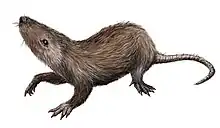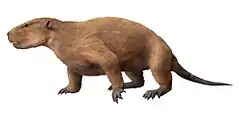| Paracimexomys Temporal range: Late Cretaceous, | |
|---|---|
| Scientific classification | |
| Domain: | Eukaryota |
| Kingdom: | Animalia |
| Phylum: | Chordata |
| Class: | Mammalia |
| Order: | †Multituberculata |
| Clade: | †Paracimexomys group |
| Genus: | †Paracimexomys |
| Species | |
| |
Paracimexomys is a genus of extinct mammals in the extinct Multituberculata order. Paracimexomys lived during the Cretaceous period. The few fossils remains come from North America. Some Romanian fossils were also tentatively assigned to this genus, though that classification now seems doubtful.
The genus Paracimexomys ("beside Cimexomys") was named by Archibald J.D. in 1982. Paracimexomys fossils were originally referred to as Cimexomys, until it was realized they were different enough to justify a genus of their own.
Species
- Paracimexomys magister also known as Cimexomys magister- Remains were found in the Upper Santonian (Upper Cretaceous) of Utah, USA. The animal probably weighed about 100g when it was alive.
- Paracimexomys magnus also known as Cimexomys magnus- were found in the Campanian (Upper Cretaceous) strata of the Judith River Formation in Montana, USA.
- Paracimexomys priscus- Fossil remains were found in the Maastrichtian (Upper Cretaceous) of Hell Creek, Montana. Remains were first found in 1966. The holotype is in the collection of the University of Alberta, where the name Cimexomys is favoured. Weight is estimated to have been 60g.
Misassigned species
- Paracimexomys crossi- Remains have been found in the Middle Cretaceous (Upper Aptian to lower Albian) Antlers Formation of Oklahoma, USA. Based on a tiny tooth, this was the first reported Oklahoma Mesozoic mammal. It's also the oldest known member of the informal Paracimexomys group. The species' name honours the prison officer Bobby Cross, who has found this and other fossils.
- Paracimexomys perplexus- Found in the late Albian to early Cenomanian (Upper Cretaceous) in the Cedar Mountain Formation of Utah.
- Paracimexomys robisoni- Found in the Middle Cretaceous strata of the Cedar Mountain Formation of Utah. This type of fossil can be found in the Oklahoma Museum of Natural History. This mouse-sized animal weighed about 25g.
- Paracimexomys bestia is now the type species of Cedaromys.
References
- ↑ Hunter, J. P; Heinrich, R. E. & Weishampel, D. B. (2010). "Mammals from the St. Mary River Formation (Upper Cretaceous), Montana". Journal of Vertebrate Paleontology. 30 (3): 885–898. doi:10.1080/02724631003763490. S2CID 128823128.
Further reading
- Sahni, A (1972). "The vertebrate fauna of the Judith River Formation, Montana. Bulletin of the AMNH". Bulletin of the American Museum of Natural History. 147. article 6. hdl:2246/1099.
- Cifelli (1997). "First notice on Mesozoic mammals from Oklahoma". Oklahoma Geology Notes. 57: 4–17.
- Archibald (1982), "A study of Mammalia across the Cretaceous-Tertiary boundary in Garfield County, Montana". Univ. of Calif Publ Geol Sci 122 xvi, p. 1-286.
- Eaton, J; Nelson, M (1991). "Multituberculate mammals from the Lower Cretaceous Cedar Mountain Formation, San Rafael Swell, Utah". Contributions to Geology. 29 (1): 1–12.
- Eaton, J; Cifelli, R (2001). "Multituberculate mammals from near the Early-Late Cretaceous boundary, Cedar Mountain Formation, Utah" (PDF). Acta Palaeontologica Polonica. 46 (4): 453–518.
- Kielan-Jaworowska Z, Hurum JH (2001). "Phylogeny and Systematics of multituberculate mammals" (PDF). Palaeontology. 44 (3): 389–429. doi:10.1111/1475-4983.00185. S2CID 83592270.
This article is issued from Wikipedia. The text is licensed under Creative Commons - Attribution - Sharealike. Additional terms may apply for the media files.

